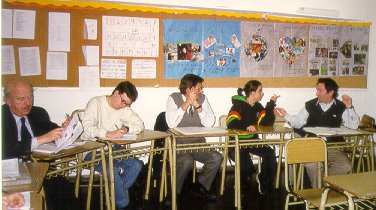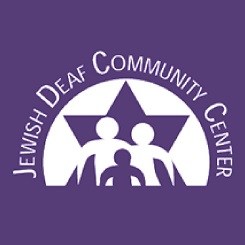 Communidad Bel El in Buenos Aires, Argentina is seeking financial contributions to continue its recent efforts to accommodate Deaf Argentina Jews. The country is currently experiencing economical upheaval with 20% unemployment in a country that has a population of 32 million people, 250,000 of them are Jewish.
Communidad Bel El in Buenos Aires, Argentina is seeking financial contributions to continue its recent efforts to accommodate Deaf Argentina Jews. The country is currently experiencing economical upheaval with 20% unemployment in a country that has a population of 32 million people, 250,000 of them are Jewish.
The first wave of Jewish immigration came from Spain in 1492 and then western Europe, especially France, during the mid-1880’s. Argentina’s first president, Bernardino Rivadavia who abolished the Inquisition created an atmosphere of tolerance, freedom and respect for human rights. The first Jewish wedding on record was held in Buenos Aires in 1860 and the first minyan for High Holiday Services was held in 1892.
Over one-third of the country’s population lives in the country’s capitol of Buenos Aires. Spanish is the universal language but many natives and immigrants speak other languages. Along with the Anglo-Argentinians and Jews, other ethnic groups include Japanese, Cileans, Bolvians, Paraguayans, Uruguayans and Indian tribes (Quechua, Mapuche, Matacos and Tobas).

Independence
After being inhabited by Indian tribes for many years and fighting against the Incas, Spanish, British and French, Spain recaptured Argentina from France. The country’s culture is greatly influenced by these European. The Basque and Irish liked to rear sheep; the Germans and Italians went into farming, the British developed the country’s infrastructure, and Jewish people went into the fur, textile, chemical, electronic and auto industries.
With an open door policy for immigrants, a third wave of Jews came from Russia and other Eastern counries in the late 1880’s to escape poverty and pogroms. Jewish immigration also grew between 1906 and 1912, mostly Ashkenazi Jews. A large number of Sephardic Jews also moved in from Morocco. By 1920, more than 150,000 Jews lived in Argentina.
Current Status
Poverty in Argentina is increasing, which in turns also affects the middle class especially the small and medium sized businesses. Many Jewish owners lost their shops, their incomes and eventually unable to support or join Jewish synagogues and organizations. The Joint Distribution Committee and the Jewish Agency are training new young Jewish leaders to rebuild and run the community.
The Jewish Community in Buenos Aires can be found in the Once district, where several synagogues, a Jewish cultural center, concerns, Jewish clubs and sports groups, a small Jewish museum in one of the synagogues (Congregation Israelita de la Republica Argentina), Jewish Theological Seminary (A Conservative rabbinical school), a couple of high schools, and one of the four remaining Yiddish daily newspapers in the world are found (the others are in Paris, Tel Aviv and Birobidjan, Sibera).
 Deaf Jews in Buenos Aires
Deaf Jews in Buenos Aires
Although most of the synagogues were built before World War II, Communidad Bel El was founded in the early 1960’s. A conservative temple, it has kept up with Argentina’s growth. They provide regular Saturday morning services and a day school. For now over three years, they have also taken on the task of the young and older adults from the Jewish deaf. According to the congregation president, Isabel Bacher, their program reaches about 30 deaf people.
The program was the idea of Rabbi Daniel Goldman who heard about Jewish deaf meeting at churches since they had no meeting place. Activities encourage deaf people to participate in the congregational activities and attend weekly courses on Jewish language, history and tradition. These classes are held every Thursday evening where participants can learn about Judaism, some Hebrew and history of the Holocaust. They have also added more activities such as guest speakers to talk about Jewish holidays and customs such as brit milah, anti-Semitism, and the State of Israel.
 Eighty percent of its members use sign language, The younger people are more likely to be oralists as the oral method is used in some schools, especially private schools for the deaf in Argentina. Only a few schools use sign language or provide interpreters for deaf students. Some secondary schools integrate both hearing and deaf.
Eighty percent of its members use sign language, The younger people are more likely to be oralists as the oral method is used in some schools, especially private schools for the deaf in Argentina. Only a few schools use sign language or provide interpreters for deaf students. Some secondary schools integrate both hearing and deaf.
Even among some schools or educational programs for the deaf, there are different signs or gestures. A sign language interpreter who is Jewish is used during classes and religious activities along with their staff of two educators and invited guests. Deaf members are always included at the community Seders and High Holy Days services, given an aliya (being called up to the podium to read the Torah), and two of them had their Bar and Bat Mitzvah conducted in sign language last March. More recently they hosted a special community Seder where they filled two tables with deaf Jewish people and their families. The congregation also saves places during Rosh Hashana and Yom Kippur services.
 Challenges
Challenges
Communidad Bel El is now trying to formalize services to the general Deaf Community. The plan is to open an office but due to the country’s current economic decline and high employment, they find it difficult to raise the $4,000 annual cost of this project. They are concerned also that other deaf Jews were not interested in receiving Jewish education due to intermarriage – marrying people of different religions. Some of them have e-mail, others have fax but none speaks English.
Who Are The Jewish Deaf Argentinians?
Communidad Bet El’s Isabel Bacher explains that some of them are single, some married and some separated. Some live with their parents. And like other hearing Jews, some of them have difficulties with their economic situations. Though, sign language and gestures in Argentina are different from other sign languages in other South American countries, some of deaf Jews of Argentina do have contacts with other deaf Jews elsewhere in South America.
For further information, contact Isabel Bacher at Communidad Bet El via e-mail address: [email protected].





